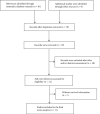Prognostic and Clinical Significance of Aspartate Aminotransferase-to-Lymphocyte Ratio Index in Individuals with Liver Cancer: A Meta-Analysis
- PMID: 35186165
- PMCID: PMC8850034
- DOI: 10.1155/2022/3533714
Prognostic and Clinical Significance of Aspartate Aminotransferase-to-Lymphocyte Ratio Index in Individuals with Liver Cancer: A Meta-Analysis
Abstract
Objective: This study was aimed at exploring the prognostic and clinicopathological roles of aspartate aminotransferase-to-lymphocyte ratio index (ALRI) in patients with hepatocellular carcinoma via a meta-analysis.
Methods: The PubMed, Embase, Cochrane Library, Web of Science, China National Knowledge Infrastructure (CNKI), Wanfang, and VIP databases were comprehensively searched from inception to November 20, 2021. Pooled hazard ratio (HR) and corresponding 95% confidence interval (CI) were used to evaluate the relationship between ALRI and overall survival (OS) as well as progression-free survival (PFS) in patients with hepatocellular carcinoma. Odds ratio (OR) and the corresponding 95% CI were also used to investigate correlations between clinical factors and ALRI in patients with hepatocellular carcinoma.
Results: A total of 3914 patients with hepatocellular carcinoma from eleven retrospective cohorts were included in this meta-analysis. The combined results revealed that patients with hepatocellular carcinoma with elevated ALRI tended to have unfavorable OS (HR 1.53 [95% CI 1.25-1.82]; P < 0.001). Pooled HRs revealed that high ALRI was an independent risk factor for inferior PFS in patients with hepatocellular carcinoma (HR 1.36 [95% CI 1.10-1.63]; P < 0.001). In addition, high ALRI was strongly associated with male sex (OR 1.32 [95% CI 1.02-1.70]; P = 0.035), presence of cirrhosis (OR 1.68 [95% CI 1.01-2.81]; P = 0.046), larger tumor size (OR 2.25 [95% CI 1.31-3.88]; P < 0.001), presence of portal vein tumor thrombus (OR 2.50 [95% CI 1.52-4.11]; P < 0.001), and distant metastasis (OR 1.72 [95% CI 1.05-2.82]; P = 0.031).
Conclusion: Elevated ALRI in patients with hepatocellular carcinoma predicted inferior survival outcomes and was strongly associated with some important features of hepatocellular carcinoma.
Copyright © 2022 Xiulan Peng et al.
Conflict of interest statement
The authors declared that the research was conducted in the absence of any commercial or financial relationships that could be construed as a potential conflict of interest.
Figures




References
-
- Center M. M., Jemal A. International trends in liver cancer incidence rates. Cancer Epidemiology, Biomarkers & Prevention . 2011;20(11):2362–2368. - PubMed
Publication types
MeSH terms
Substances
LinkOut - more resources
Full Text Sources
Medical

